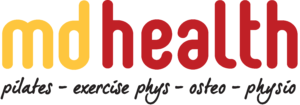Running is a popular form of exercise to improve cardiovascular fitness and is performed by a wide range of people. Here at MD Health we often see clients who have injuries from trying to return to running or after completing large amounts of running without appropriate preparation.
Here are some handy tips to prevent injuries for people who are preparing to run a marathon, half marathon, their first 5km run or even those looking to just give it a go for the first time.
Select Appropriate Footwear
It is important to consider the type of shoe you will be wearing when running to ensure it is appropriate for your foot type and running style.
For example if your feet are somewhat flat and pronated, you may require a shoe with more support through the arch, or if your foot posture is quite normal you may be able to run in a shoe with little structural support.
Running in a shoe which is not suitable can lead to many injuries including plantar fasciitis, shin splints and knee pain. Ideally you can get this checked by a qualified professional such as a sports podiatrist who can guide you towards selecting an appropriate shoe rather than just choosing the shoe which looks the nicest!
Manage Your Training Load
Monitoring your training load is important to continually improve towards your goals but also to ensure that you are not over training and placing yourself at risk of over-use injuries which we often see in recreational and competitive runners.
For someone just starting regular running, intervals of jogging then walking is a good way to ease your body into running and then gradually increase the jogging time vs the walking time until you can run a certain distance continuously.
For the recreational or competitive runner training for a 10km fun run or marathon event, slowly building up your training load and recording your distance, time and how you felt after each run is a good way to monitor for any signs of over-training during your preparation.
Strengthen Your Body
Because running is such a repetitive movement, it is important to have adequate strength and endurance in the main muscle groups involved in running.
This includes appropriately strengthening your calves, quadriceps, hamstrings and glutes to ensure you have power and strength in these muscles to accelerate.
It is also really important to have a good level of pelvic stability to prevent lower back pain when running as there is a lot of pressure on this area when running. This would involve having good strength and control of your glutes and abdominal stabilising muscles.
Quality Over Quantity
Many people think that running for longer periods of time is the best way to increase your fitness. However in the untrained runner this can lead to a lot of injuries as running with poor technique when fatigued can place excessive pressure on the joints of the body including the knees, ankles and hips.
It is far better to run with good technique at a slightly higher intensity for a shorter period of time as you will not only use more calories but also reduce your risk of injury by not excessively loading your joints.
Written By Jack Hickey
Exercise Physiologist at MD Health Pilates


